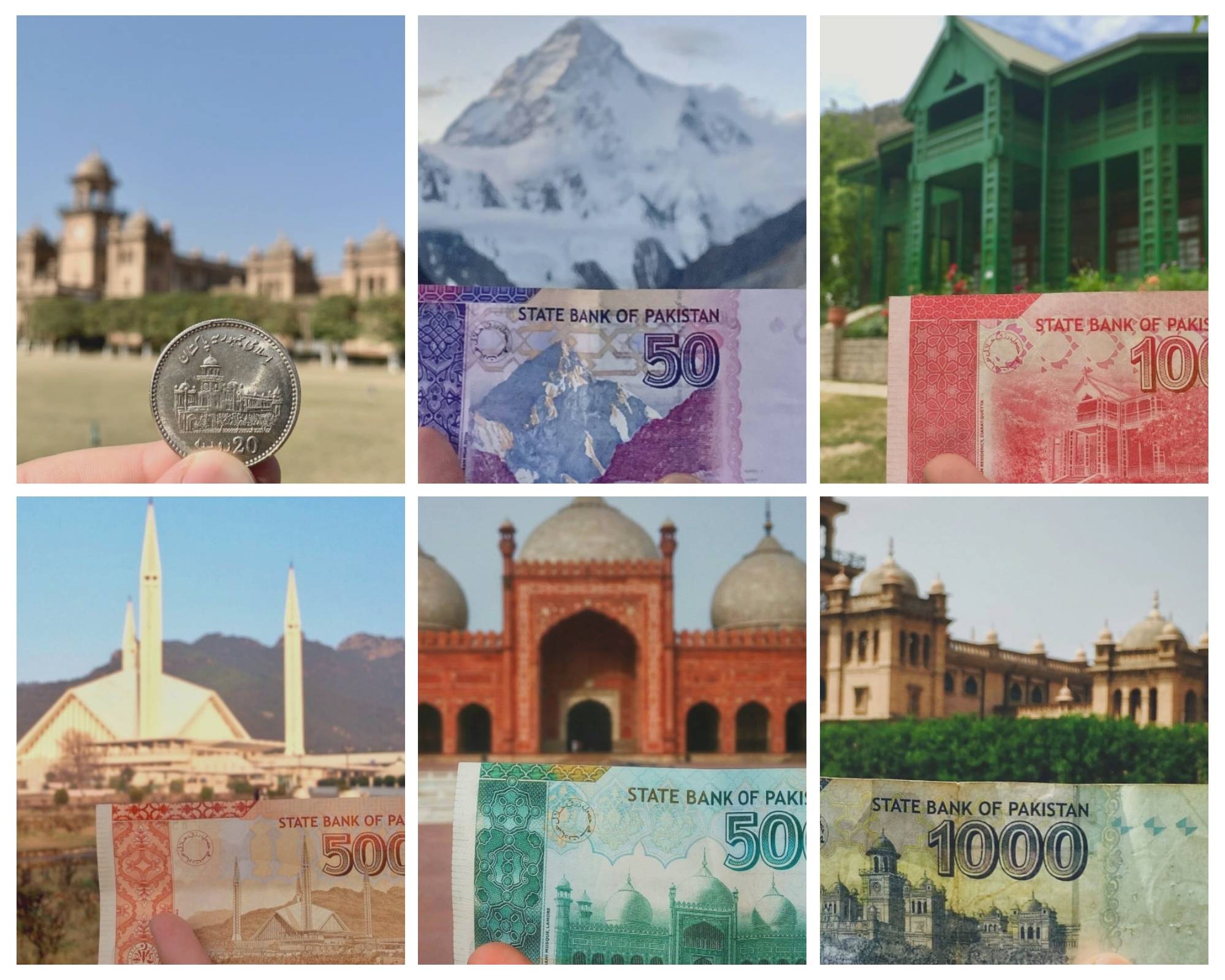Here are the details of the Pakistani local currency notes and coins front side and rear side printed pictures details.
Have you ever looked at the back of your local currency notes and wondered what the rankings would look like in real life?
Here are details of Pakistani currency notes and coins, showcasing pictures of historical places printed on their front and back sides.
Pakistani currency notes are more than just a medium of exchange; they are a canvas that showcases the rich history, culture, and architectural marvels of the nation. From ancient archaeological sites to iconic modern structures, the designs on these notes reflect Pakistan’s diverse heritage.
In this article, we explore the historical places depicted on Pakistani rupee notes, delving into their significance and the stories they tell.
You may also like: All you need to know the best historical places of Pakistan
Pakistani 2 rupees Coin

These two rupees coins bear an engraving of Pakistan’s most famous historical site, the Badshahi Masjid of Lahore.
Pakistan 10 Rupees Coin

Pakistan 10 rupees coin carved with Pakistan’s iconic historical place of Pakistan the Faisal Mosque of Pakistan.
Pakistani 20 rupees coin

These 20 Pakistani rupee coins feature an engraving of Islamia College Peshawar University, a historic educational institution over a century old, on their reverse side.
Pakistani 10 Rupees

The back of the Pakistani 10 rupees note showcases the Khyber Pass of Peshawar. This historic route enabled numerous invaders, from Alexander the Great to the Mughals and the Afghans, to conquer India.
Pakistan 50 Rupees

The 50 Rupees currency note features a picture of K2, the world’s second-highest mountain after Mount Everest. This stunning location lies in Gilgit Baltistan near the Pak-China border.
Pakistan 100 Rupees

Ziarat Residency, also known as Quaid-e-Azam Residence, appears on the back of the Pakistani 100 rupees note.
The back side of the 100 rupee note in Pakistan features the Zayarat residency, also known as the Quaid-e-Azam residence.
This historical place holds great significance as it was the residence of Quaid-e-Azam Muhammad Ali Jinnah, the founder of Pakistan.
The note displays the simple and elegant architecture of the residence, symbolizing Quaid-e-Azam’s immense contribution to shaping the nation. This depiction on the currency serves as a reminder of his leadership and vision for Pakistan.
Pakistan 500 rupees

The back of the 500 rupees note features Pakistan’s most renowned historical site, the Badshahi Mosque in Lahore.
The back side of the 500 rupee note in Pakistan features the iconic Badshahi Mosque in Lahore. This historical masterpiece is one of the most well-known landmarks in the country.
The Badshahi Mosque, constructed during the Mughal era, is a symbol of grandeur and architectural brilliance. Its impressive domes, minarets, and intricate design attract visitors from all around the world.
This depiction of the currency pays homage to the rich cultural heritage and religious significance of the Badshahi Mosque, making it a true national treasure of Pakistan.
Pakistan 1000 Rupees

The image of Islamia College Peshawar University adorns the back of the Pakistani 1000 rupees note.
“In Pakistan, the back side of the 1000 Pakistani rupees note features a picture of Islamia College Peshawar University.
This institution holds great historical and educational significance in the country.
Featured on earlier designs of the Rs. 100pnote, Islamia College in Peshawar is a landmark of colonial-era architecture and educational heritage. Founded in 1913 by Sir Sahibzada Abdul Qayyum and other visionaries, the college aimed to blend modern education with Islamic values.
Its stunning red-brick structure, inspired by Mughal and Victorian styles, has produced countless leaders, including politicians, scholars, and poets.Islamia College played a key role in the Pakistan Movement, making it a fitting choice for the currency.
Today, it stands as a prestigious university, continuing its legacy of enlightenmen
The college’s architecture, featuring its iconic clock tower and grand facade, graces the note, symbolizing Pakistan’s rich academic heritage.
Pakistan 5000 Rupees note

The Faisal Mosque in Islamabad, Pakistan, is an iconic landmark that holds great significance. It is a symbol of Pakistan’s rich history and cultural heritage.
The mosque’s grandeur and magnificence have earned it a worthy spot on Pakistan’s 5,000 currency note.
This recognition serves as a tribute to the mosque’s architectural beauty, religious importance, and its role in promoting peace and unity in the country.
The Rs. 500 note showcases the Faisal Mosque in Islamabad, a striking example of contemporary Islamic architecture.
Completed in 1986 and designed by Turkish architect Vedat Dalokay, the mosque’s unique tent-like structure and towering minarets set it apart from traditional designs.
Nestled against the Margalla Hills, Saudi Arabia’s King Faisal gifted the mosque, naming it after himself to symbolize Pak-Saudi friendship. Capable of accommodating over 100,000 worshippers, Faisal Mosque serves not only as a place of prayer but also as a national icon.
Its image on the Rs. 500 note reflects Pakistan’s modern achievements and its deep Islamic roots.Why It Matters: Faisal Mosque bridges tradition and modernity, embodying Pakistan’s aspirations on the global stage.
Pakistan 75 Rupees note

The new Rs 75 rupees note in Pakistan features the national mascot, the Markhor, on its backside. The Markhor is a majestic and endangered species that represents the country’s rich wildlife and natural heritage.
It symbolizes strength, resilience, and Pakistan’s commitment to conservation. The inclusion of the Markhor on the currency highlights the importance of preserving this magnificent animal and raising awareness about the need for wildlife conservation in Pakistan.
Whether you’re a traveler eager to visit these sites or a collector of currency, Pakistan’s notes offer a window into its remarkable heritage. Which of these historical places fascinates you the most? Let us know in the comments below!


